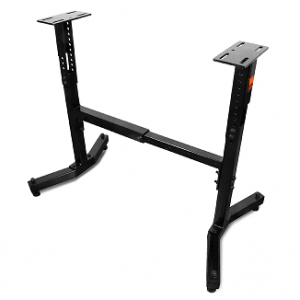- Joined
- Apr 8, 2023
- Messages
- 23
I wanted a hefty base and stand for my Sherline 4410 CNC ready lathe. It may be overkill, but plan to use a 1/4" steel plate I had left over from another project. I also wanted a nice chip tray, so got one off of LittleMachineShop that was intended for 7 X 16 Mini lathe, part number 5506. I may need to make some kind of back splash later to keep my garage drywall oil free.
All the dimensions seem to work. To order anything on-line these days that is heavy costs a lot for shipping, so I found the adjustable Wen 225 lbs capacity (Wood lathe) stand from Home Depot, low cost and free shipping to my door. It is also adjustable so I can fuss with the height since I don't know what is comfortable to use for me yet or what is recommended.
The idea is from the ground up, stand, steel plate, chip tray, Sherline 4410 lathe.
After reviewing some of HM forum's threads, I know others have used wood, plywood, particle board, and aluminum C channel. With some good successes, with Melamine-coated MDF for example, over 20 years, applied to the Sherline lathes. I just wanted to add some mass and stiffness to the base, while keeping my costs low and use what I have on hand (other than the stand; I also didn't want to eat up any of my existing bench space).
I really didn't want to risk using wood for the base. It may be totally fine, but to be honest, I'm just getting started so for me I'd rather eliminate any potential issues up front that I may have to solve later or that could affect the quality of the results I get and not figure out why until years later. I do know larger more powerful machines have some mass to them, this is for good reason, my wife also has an industrial Sailrite sewing machine and it has a lot of heft to it too compared to the normal sewing machine she has.
I'm interested to hear any comments or feedback and suggestions, since this is my first time doing this.
I'm not sure what to use to shim the lathe when leveling things out. I read somewhere that I can rip apart one of those feeler gauge sets and use one or more of those to prop things up. Maybe there are other techniques too. I got a machinists level, so I'm up to the task after I get the stand in its final resting place.
I attached some pictures, sorry - hard to see some of my white layout lines with the sun, but the plate I plan to cut down to about the dimensions of the chip tray. I have a Lotos LTP5000D red plasma cutter to cut the plate to size, but need to wait until new consumables arrive from Amazon since the tip on it now is destroyed.
Thanks, Phil
All the dimensions seem to work. To order anything on-line these days that is heavy costs a lot for shipping, so I found the adjustable Wen 225 lbs capacity (Wood lathe) stand from Home Depot, low cost and free shipping to my door. It is also adjustable so I can fuss with the height since I don't know what is comfortable to use for me yet or what is recommended.
The idea is from the ground up, stand, steel plate, chip tray, Sherline 4410 lathe.
After reviewing some of HM forum's threads, I know others have used wood, plywood, particle board, and aluminum C channel. With some good successes, with Melamine-coated MDF for example, over 20 years, applied to the Sherline lathes. I just wanted to add some mass and stiffness to the base, while keeping my costs low and use what I have on hand (other than the stand; I also didn't want to eat up any of my existing bench space).
I really didn't want to risk using wood for the base. It may be totally fine, but to be honest, I'm just getting started so for me I'd rather eliminate any potential issues up front that I may have to solve later or that could affect the quality of the results I get and not figure out why until years later. I do know larger more powerful machines have some mass to them, this is for good reason, my wife also has an industrial Sailrite sewing machine and it has a lot of heft to it too compared to the normal sewing machine she has.
I'm interested to hear any comments or feedback and suggestions, since this is my first time doing this.
I'm not sure what to use to shim the lathe when leveling things out. I read somewhere that I can rip apart one of those feeler gauge sets and use one or more of those to prop things up. Maybe there are other techniques too. I got a machinists level, so I'm up to the task after I get the stand in its final resting place.
I attached some pictures, sorry - hard to see some of my white layout lines with the sun, but the plate I plan to cut down to about the dimensions of the chip tray. I have a Lotos LTP5000D red plasma cutter to cut the plate to size, but need to wait until new consumables arrive from Amazon since the tip on it now is destroyed.
Thanks, Phil





